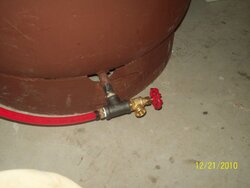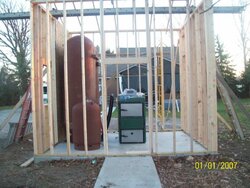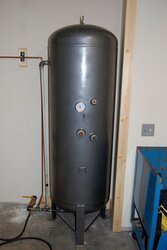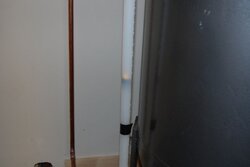I am adding 500 more gallons of storage to my system was wondering who has had success with building thier own.I currently have one amtrol sx-90v but would not mind saveing the cash .Thanks Dave
Who has built their own expansion tank ?.
- Thread starter bernard
- Start date
-
Active since 1995, Hearth.com is THE place on the internet for free information and advice about wood stoves, pellet stoves and other energy saving equipment.
We strive to provide opinions, articles, discussions and history related to Hearth Products and in a more general sense, energy issues.
We promote the EFFICIENT, RESPONSIBLE, CLEAN and SAFE use of all fuels, whether renewable or fossil.
You are using an out of date browser. It may not display this or other websites correctly.
You should upgrade or use an alternative browser.
You should upgrade or use an alternative browser.
- Status
- Not open for further replies.
I built one. Got the idea from robc If I remember correctly. Used a 124 propane tank. At least thats what they called it at
the scrap yard. Had to add a inlet at the bottom and put a shader valve in one of the holes in the top. Be sure to fill with water to
flush out any gas left in the tank before drilling your hole. A regular hole saw with cutting oil works good. The nice thing about these
tanks is that you can use the original float gauge to moniter water level. I'v had to add air once. Don't Know if it was due to traped air in the system that worked it's way out or if the air was asorbed into the water. This summer I will put a layer of mineral oil on top the water in the tank to make sure no air is being asorbed. Here's a photo.
The date in the bottom pic is a few years off.
the scrap yard. Had to add a inlet at the bottom and put a shader valve in one of the holes in the top. Be sure to fill with water to
flush out any gas left in the tank before drilling your hole. A regular hole saw with cutting oil works good. The nice thing about these
tanks is that you can use the original float gauge to moniter water level. I'v had to add air once. Don't Know if it was due to traped air in the system that worked it's way out or if the air was asorbed into the water. This summer I will put a layer of mineral oil on top the water in the tank to make sure no air is being asorbed. Here's a photo.
The date in the bottom pic is a few years off.
Attachments
That looks easy enough how much water do you put in and how much oil will you add. Will you take out the air valve to add oil? how much air pressure. Thanks Dave
bernard said:That looks easy enough how much water do you put in and how much oil will you add. Will you take out the air valve to add oil? how much air pressure. Thanks Dave
I just put enough water in the bottom to cover the inlet outlet pipe a little. I think the gauge said about 12% cold. I have a shutoff valve at the other end of the pex that is not in the picture. You then shut that off Pre-charge your tank to your min
system pressure. Usually 12 psi for a 2 story house. Pressurize the rest of your system to the same psi cold then
open the valve and should be good to go. As for oil Ill take a plug or air valve out of the top and pour it in. Then I'll have
to re-pressurize. Probably a gallon would be plenty I'd think.
I made one also. I pulled the original float gauge because my tank is taller. I used a piece of Wirsbo hepex for a sight tube. I have a Thill float in the tube but it stopped floating. It was made of plastic and I may have compromised it when I cut the bottom peg off the float. Try to find another type of ball that floats. I can still see the water level fine.
Overall it works, but I might pull it and use it for a buffer tank in my basement. I would get another one for the expansion tank. Maybe something shorter that I could put in one of the Bell & Gosset valves that returns air to the Expansion tank.
gg
Overall it works, but I might pull it and use it for a buffer tank in my basement. I would get another one for the expansion tank. Maybe something shorter that I could put in one of the Bell & Gosset valves that returns air to the Expansion tank.
gg
Attachments
Thanks goosegunner . I also will have 1000 gallons of storage. What is the purpus of an additional buffer tank?. Dave
There are a few benefits from what I gather.
The primary one for me is that my boiler and storage is 130' from my garage where I have a primary/secondary manifold. From there it is another 45-50' to my furnace and water heater. My manifold in the garage uses circulators controlled on demand by a Taco zone controller. If I put the buffer tank in my basement the system would maintain hot water in the buffer tank within feet of my furnace. That way I would not have the 2-3 minutes of furnace fan running with mild temp water.
I do not have my DHW hooked up yet and I do not think it would work very well with the current configuration. With a buffer tank it will always have hot water to immediately heat DHW instead of waiting for the lines to purge the cool to warm water. This would be more of a problem in warmer weather as circulation of water diminishes due to low demand.
Before storage I ran the Primary pump in the manifold continuously so Hot water was always right there. With storage that would just mix the tank because I would be returning hot water to the bottom of the tank when there is no call from the load.
Lastly, You can deplete the btu's in the buffer tank before returning to storage. That way you do not mix storage as much with water returning to storage that is much warmer than the bottom of the tank.
Ideally storage would be in my basement. I did not do it that way for 2 reasons.
1. I heat my pool in the summer and I see little point in having a 1000 gallon heated tank in my basement when I am running my air conditioner.
2.Lack of room in a finished basement.
gg
The primary one for me is that my boiler and storage is 130' from my garage where I have a primary/secondary manifold. From there it is another 45-50' to my furnace and water heater. My manifold in the garage uses circulators controlled on demand by a Taco zone controller. If I put the buffer tank in my basement the system would maintain hot water in the buffer tank within feet of my furnace. That way I would not have the 2-3 minutes of furnace fan running with mild temp water.
I do not have my DHW hooked up yet and I do not think it would work very well with the current configuration. With a buffer tank it will always have hot water to immediately heat DHW instead of waiting for the lines to purge the cool to warm water. This would be more of a problem in warmer weather as circulation of water diminishes due to low demand.
Before storage I ran the Primary pump in the manifold continuously so Hot water was always right there. With storage that would just mix the tank because I would be returning hot water to the bottom of the tank when there is no call from the load.
Lastly, You can deplete the btu's in the buffer tank before returning to storage. That way you do not mix storage as much with water returning to storage that is much warmer than the bottom of the tank.
Ideally storage would be in my basement. I did not do it that way for 2 reasons.
1. I heat my pool in the summer and I see little point in having a 1000 gallon heated tank in my basement when I am running my air conditioner.
2.Lack of room in a finished basement.
gg
goosegunner said:There are a few benefits from what I gather.
The primary one for me is that my boiler and storage is 130' from my garage where I have a primary/secondary manifold. From there it is another 45-50' to my furnace and water heater. My manifold in the garage uses circulators controlled on demand by a Taco zone controller. If I put the buffer tank in my basement the system would maintain hot water in the buffer tank within feet of my furnace. That way I would not have the 2-3 minutes of furnace fan running with mild temp water.
I do not have my DHW hooked up yet and I do not think it would work very well with the current configuration. With a buffer tank it will always have hot water to immediately heat DHW instead of waiting for the lines to purge the cool to warm water. This would be more of a problem in warmer weather as circulation of water diminishes due to low demand.
Before storage I ran the Primary pump in the manifold continuously so Hot water was always right there. With storage that would just mix the tank because I would be returning hot water to the bottom of the tank when there is no call from the load.
Lastly, You can deplete the btu's in the buffer tank before returning to storage. That way you do not mix storage as much with water returning to storage that is much warmer than the bottom of the tank.
Ideally storage would be in my basement. I did not do it that way for 2 reasons.
1. I heat my pool in the summer and I see little point in having a 1000 gallon heated tank in my basement when I am running my air conditioner.
2.Lack of room in a finished basement.
gg
I think on a new system the buffer tank is the way to go. However, I've been thinking of using a Johnson Controls A419 aquastat on my existing primary loop to only keep it at the minimum useable temp that should be able accomplish the same thing as the buffer tank. That is only returning cool water back to the bottom of storage. I'm Ok with lukewarm air out of the registers since the heat pump already works that way now with the blower running considerably more than a gas "hot" air furnace. I actually find it much more comfortable and we don't seem to get sick as much as our last home which had the hot cold hot cold cycle all winter long. The extra blower electricity is probably negligible. Radiant, euro fads, or radiators are still the best but I'm pleasantly surprised how well this works. My wood stat is set for 70 on an resistance type setting so it keeps it right at set point. The HP tstat is about 3 degrees less and it also has virtually no hysteresis either keeping the temp right at set point. When the water drops below about 105-110 degrees (per gauge, JC probe shows 87 due to less than ideal surface mount on pipe) I stop using the water to air Hx, the house cools 3 degrees and the heat pump takes over. I don't think my primary loop would need over 130 degree water to keep home at 70 even on the coldest days. I don't know if this is because my home is pretty well insulated or if most on here want hot air not lukewarm air out of their ducts. If I ever add DHW, this would complicate things more possibly requiring some sort of differential control. I could probably simplify this by charging the DHW above 130 only when the boiler is running and stick to 130 when relying on the storage.
- Status
- Not open for further replies.
Similar threads
- Replies
- 10
- Views
- 2K
- Replies
- 5
- Views
- 2K
- Replies
- 32
- Views
- 3K
- Replies
- 13
- Views
- 3K





